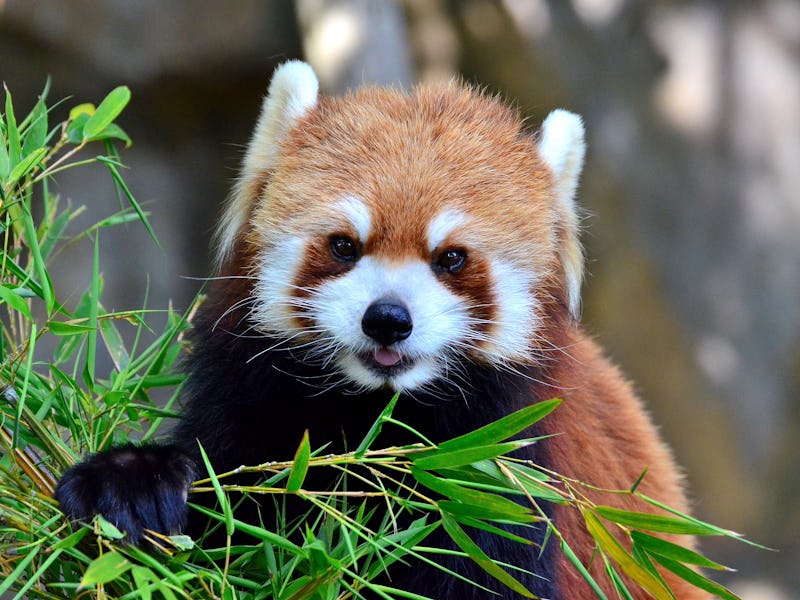The Science of Cute and Why You Want to Bite This Baby Red Panda
Cute things trigger simultaneous responses that overwhelm the senses.

If you sometimes think animals are so adorbs you want to kill them, you’re not alone. While in English there isn’t a word for an aggressive reaction to cuteness, there is, however, one in Tagalong: gigil. This Filipino phrase essentially translates to a feeling of trembling, or the gritting of teeth, in a situation of overwhelming cuteness. This is a universal human thing. This is biology.
Take the red panda. The red panda is really cute — some might say dangerously cute. If you find yourself coo’ing over its’ picture, that makes sense — our brains are hardwired to react strongly to little critters because they make us think of human babies. If something has large, wide-set eyes, round cheeks, and a small chin, people are going to be all about it.
If upon viewing the red panda you’re having thoughts like I just want to take a bite of it or it’s so cute, it’s killing me then you’re experiencing what researchers call dimorphous expressions. Emotions basically work like this: There’s a stimulus (like a cute animal), an appraisal of the event, an emotional experience, and then expressive behavior. But if the behavior is a seemingly negative one, like crying or squealing, to a positive experience, that’s a dimorphous expression.
Researchers from Yale University have been in the business of studying why dimorphous expressions occur. Back in 2013 Yale psychologists had 109 people look at cute, funny, and ‘neutral’ photos of puppies (only how a puppy photo can come off as neutral, I do not know). The majority of reactions, reports Popular Science, fell into the phenomenon of ‘cute aggression’. The researchers reasoned that the high-positive affect of the cute stimulus was just so intense, that it created a sense of lost control.
In a 2015 study by Yale, 57 female and 48 male subjects (all Mechanical Turks) looked at eight photographs of infants and toddlers. Some of the photos were morphed so that the babies looked extra cute — larger eyes, smaller lips, and noses — and some others were morphed so the babies had decidedly less-infantile characteristics. The participants were asked to rank on a scale how much they identified with statements like “When I look at this baby I feel overwhelmed with very strong positive feelings.” Their hypothesis was correct: People reported more caring and aggressive expressions after looking at the extra cute kids.
“Perhaps dimorphous displays of emotion reflect the onset of a second emotion that arises to tamper down the original overwhelming emotion,” wrote the researchers, “or perhaps dimorphous expressions elicit physiological shifts away from intense positive emotions through afferent facial or postural feedback.”
The researchers also proposed the idea that becoming physically or verbally overwhelmed in a moment of intense emotions is an evolutionary treat designed to signal to other people that the emotion-feeler is “overwhelmed or incapacitate.”
Cuteness controls the senses in more ways than provoking an aggressive response: The sight of cute can also improve concentration. A separate 2012 study titled “The Power of Kawaii” had study participants complete a fine motor dexterity task before and after looking at pictures of puppies and kittens or dogs and cats. The subjects were more successful performing the task after viewing the baby animal pictures — their attention actually became more focused after viewing the cuter pictures.
The study authors declared that cuteness-triggered emotion can be associated with positive systematic processing and motivation; the subjects became “more physically tender in their motor behavior.” Looking at baby animals triggers the part of the brain associated with caregiving and nurturing, which gets the brain to snap into focus. The brain doesn’t realize you’re not actually tasked with the physical task of taking care of a baby animal when you’re just looking at a picture.
In a case to make a cuter world, the researchers write, “Cute features not only make objects more user-friendly and approachable, but also induce behavioral tendencies in the users, which is beneficial in specific situations, such as driving and office work.”
Cute stuff: You may want to squeeze the hell out of it, but at least it can help you get shit done.